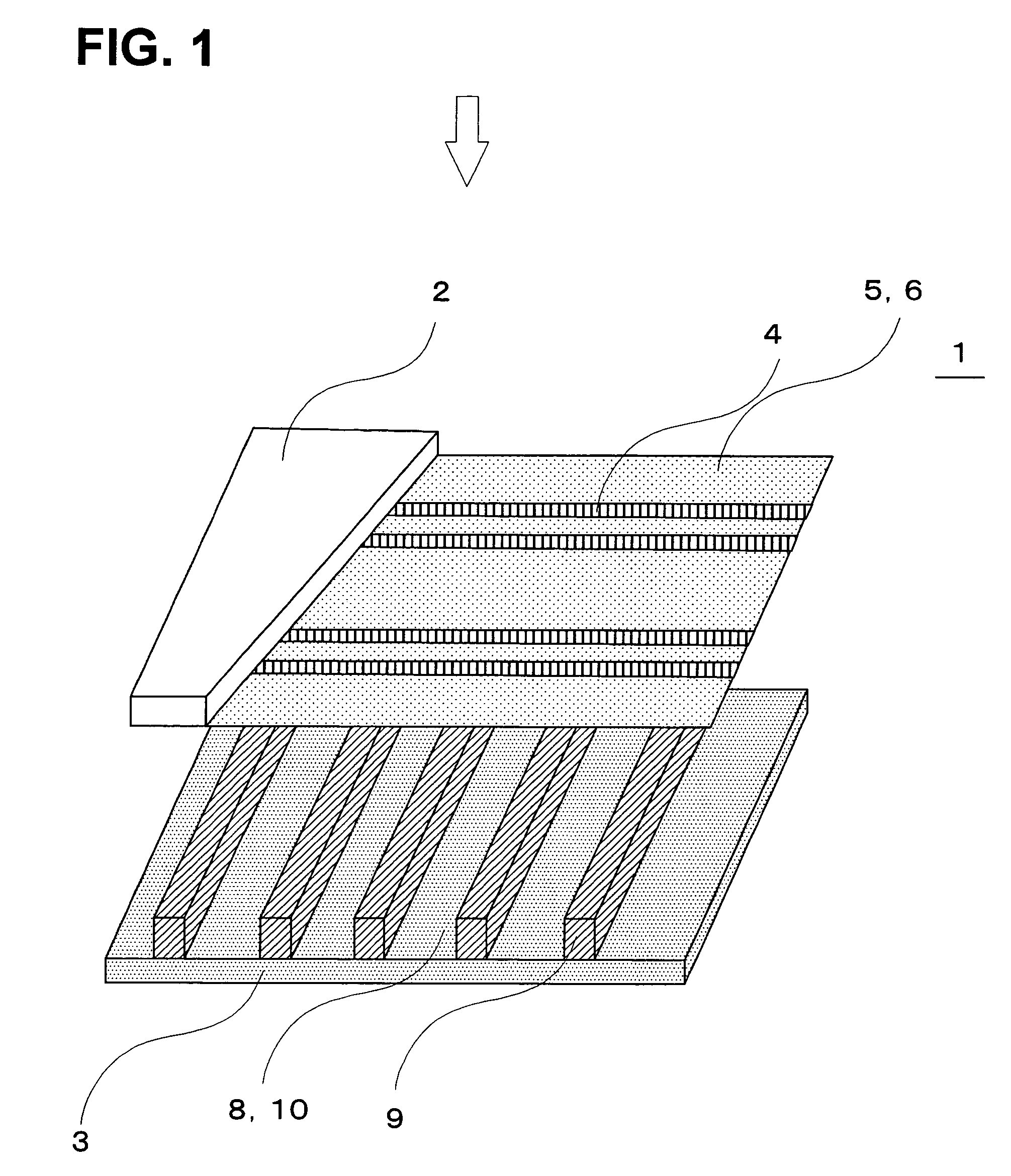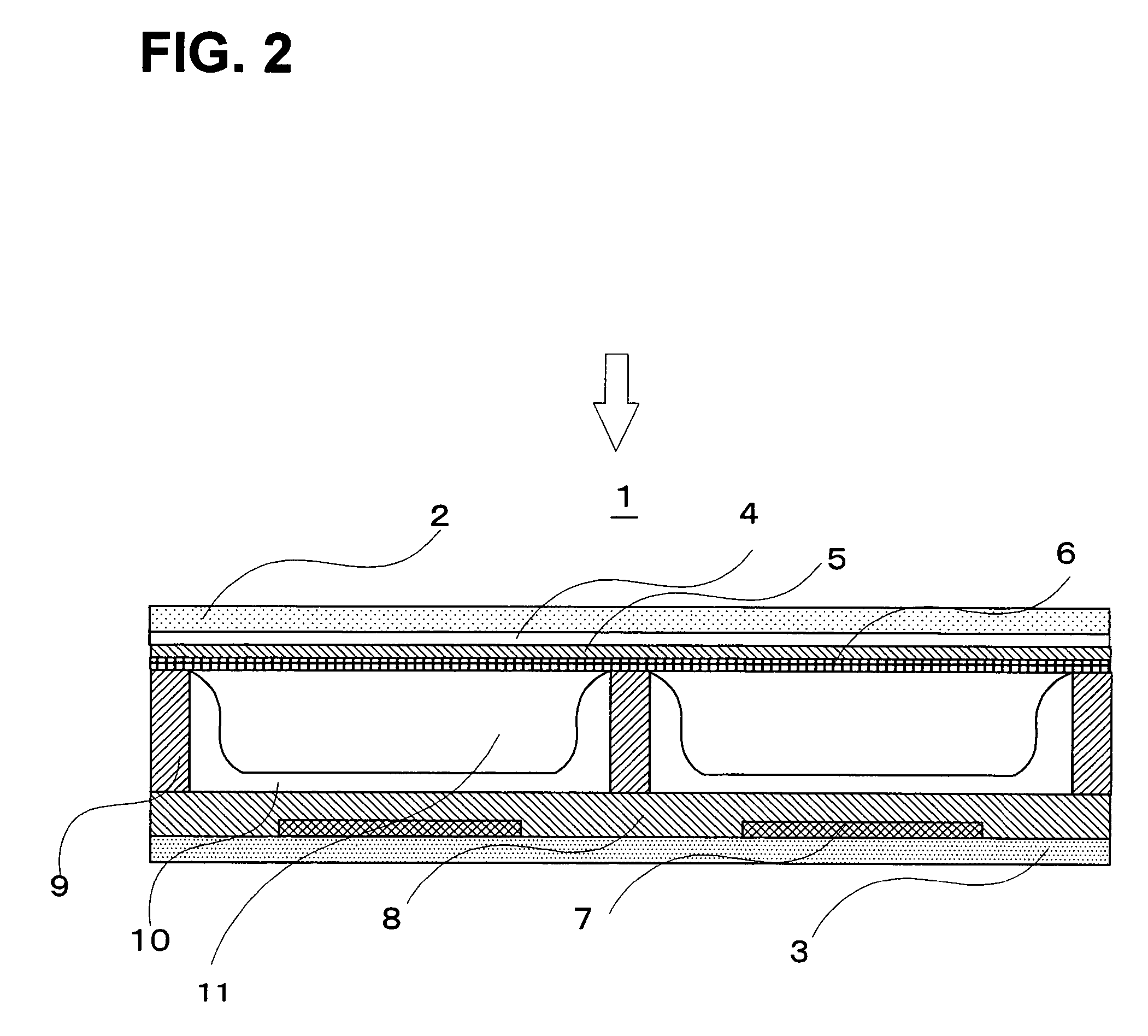Molding material transfer method and substrate structure
a technology of material transfer and substrate, which is applied in the manufacture of electrode systems, electrical discharge tubes/lamps, and address electrodes. it can solve the problems of bubble defects, defects in the ribs (underfilled parts), and bubble defects, and achieve high reliability
- Summary
- Abstract
- Description
- Claims
- Application Information
AI Technical Summary
Benefits of technology
Problems solved by technology
Method used
Image
Examples
example 1
[0088]In this example, the principle of the present invention will be described with reference to FIG. 12 to FIG. 16. FIG. 12 is a schematic plan view depicting the concave portions 111 of the intaglio plate for filling. FIG. 13 is a schematic side cross-sectional view thereof, FIG. 14 is a schematic plan view depicting the grooves 141 of the intaglio plate for transfer, FIG. 15 is a schematic side cross-sectional view thereof, and FIG. 16 is a schematic side cross-sectional view depicting a status where the concave portions 111 of the intaglio plate for filling and the grooves 141 of the intaglio plate for transfer are met. In FIG. 12 to FIG. 16, the groove patterns formed on the intaglio plate for filling and the intaglio plate for transfer are both lattices, and these shapes overlap with each other when the intaglio plate for filling and the intaglio plate for transfer are superimposed. The dimensions in FIG. 12 and the dimensions in FIG. 14 are in a 1:1 relationship, and as a co...
example 2
[0091]In this example, a molding material transfer apparatus and a substrate manufacturing apparatus in the case where the intaglio plate for filling is in the shape of a plane and the intaglio plate for transfer is bendable into be a cylindrical plane, and how to use these apparatuses, will be described.
[0092]FIG. 19 shows a status where a molding material is being filled from an intaglio plate for filling 191 placed on a flat table 194 into an intaglio plate for transfer 193 installed on a plate cylinder 192 which is in the shape of a cylindrical plane. In the grooves of the intaglio plate for filling 191, the molding material has been filled in advance. As the plate cylinder 192 rotates in the arrow direction, the intaglio plate for transfer 193 and the intaglio plate for filling 191 are partially contacted, the molding material shifts from the grooves of the intaglio plate for filling 191 to the grooves of the intaglio plate for transfer 193 by the capillary phenomenon, and the ...
example 3
[0095]In this example, a molding material transfer apparatus and a substrate manufacturing apparatus, in the case where an intaglio plate for filling is a plane and an intaglio plate for transfer is bendable, and how to uses these apparatuses, will be described.
[0096]First according to step S221 in FIG. 22, a molding material is filled into an intaglio plate for filling 191 by squeezing as shown in FIG. 23A.
[0097]Then according to step S222 in FIG. 22, an intaglio plate for transfer 193 is set facing the intaglio plate for filling 191 as shown in FIG. 23B.
[0098]Then according to step S223 in FIG. 22, the intaglio plate for transfer 193 is bent using a roller 231 as shown in FIG. 23C, so that the intaglio plate for filling 191 and the intaglio plate for transfer 193 are partially contacted, and the molding material is shifted from the grooves of the intaglio plate for filling 191 to the grooves of the intaglio plate for transfer 193 by the capillary phenomenon, and the grooves of the...
PUM
 Login to View More
Login to View More Abstract
Description
Claims
Application Information
 Login to View More
Login to View More - R&D
- Intellectual Property
- Life Sciences
- Materials
- Tech Scout
- Unparalleled Data Quality
- Higher Quality Content
- 60% Fewer Hallucinations
Browse by: Latest US Patents, China's latest patents, Technical Efficacy Thesaurus, Application Domain, Technology Topic, Popular Technical Reports.
© 2025 PatSnap. All rights reserved.Legal|Privacy policy|Modern Slavery Act Transparency Statement|Sitemap|About US| Contact US: help@patsnap.com



